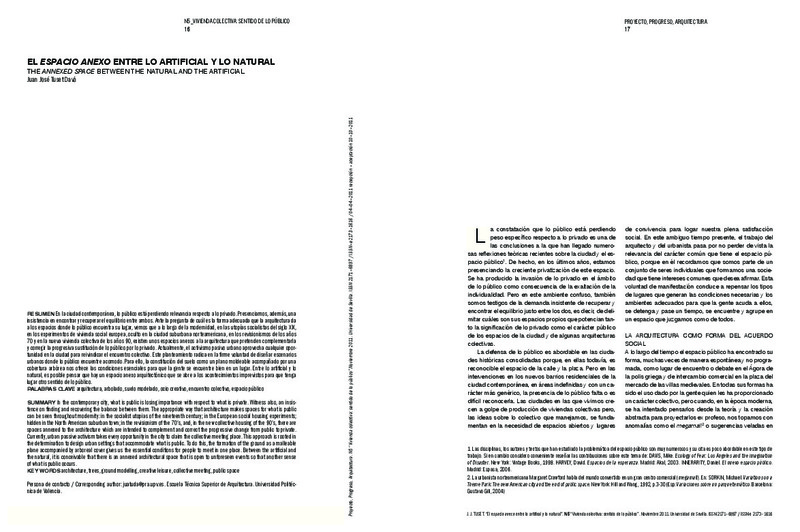JavaScript is disabled for your browser. Some features of this site may not work without it.
Buscar en RiuNet
Listar
Mi cuenta
Estadísticas
Ayuda RiuNet
Admin. UPV
El espacio anexo entre lo natural y lo artificial
Mostrar el registro sencillo del ítem
Ficheros en el ítem
| dc.contributor.author | Tuset Davó, Juan José
|
es_ES |
| dc.date.accessioned | 2015-03-10T13:31:26Z | |
| dc.date.available | 2015-03-10T13:31:26Z | |
| dc.date.issued | 2011-11 | |
| dc.identifier.issn | 2171-6897 | |
| dc.identifier.uri | http://hdl.handle.net/10251/47928 | |
| dc.description.abstract | [ES] En la ciudad contemporánea, lo público está perdiendo relevancia respecto a lo privado. Presenciamos, además, una insistencia en encontrar y recuperar el equilibrio entre ambos. Ante la pregunta de cuál es la forma adecuada que la arquitectura da a los espacios donde lo público encuentra su lugar, vemos que a lo largo de la modernidad, en las utopías socialistas del siglo XIX, en los experimentos de vivienda social europea, oculto en la ciudad suburbana norteamericana, en los revisionismos de los años 70 y en la nueva vivienda colectiva de los años 90, existen unos espacios anexos a la arquitectura que pretenden complementarla y corregir la progresiva sustitución de lo público por lo privado. Actualmente, el activismo pasivo urbano aprovecha cualquier oportunidad en la ciudad para reivindicar el encuentro colectivo. Este planteamiento radica en la firme voluntad de diseñar escenarios urbanos donde lo público encuentre acomodo. Para ello, la constitución del suelo como un plano moldeable acompañado por una cobertura arbórea nos ofrece las condiciones esenciales para que la gente se encuentre bien en un lugar. Entre lo artificial y lo natural, es posible pensar que hay un espacio anexo arquitectónico que se abre a los acontecimientos imprevistos para que tenga lugar otro sentido de lo público. | es_ES |
| dc.description.abstract | [EN] In the contemporary city, what is public is losing importance with respect to what is private. Witness also, an insistence on finding and recovering the balance between them. The appropriate way that architecture makes spaces for what is public can be seen throughout modernity: in the socialist utopias of the nineteenth century; in the European social housing experiments; hidden in the North American suburban town; in the revisionism of the 70's, and, in the new collective housing of the 90's, there are spaces annexed to the architecture which are intended to complement and correct the progressive change from public to private. Currently, urban passive activism takes every opportunity in the city to claim the collective meeting place. This approach is rooted in the determination to design urban settings that accommodate what is public. To do this, the formation of the ground as a malleable plane accompanied by arboreal cover gives us the essential conditions for people to meet in one place. Between the artificial and the natural, it is conceivable that there is an annexed architectural space that is open to unforeseen events so that another sense of what is public occurs. | es_ES |
| dc.language | Español | es_ES |
| dc.publisher | Universidad de Sevilla | es_ES |
| dc.relation.ispartof | Proyecto, Progreso, Arquitectura | es_ES |
| dc.rights | Reconocimiento - No comercial - Sin obra derivada (by-nc-nd) | es_ES |
| dc.subject | Arquitectura | es_ES |
| dc.subject | Arbolado | es_ES |
| dc.subject | Suelo modelado | es_ES |
| dc.subject | Ocio creativo | es_ES |
| dc.subject | Encuentro colectivo | es_ES |
| dc.subject | Espacio público | es_ES |
| dc.subject | Architecture | es_ES |
| dc.subject | Collective meeting | es_ES |
| dc.subject | Creative leisure | es_ES |
| dc.subject | Ground modelling | es_ES |
| dc.subject | Trees | es_ES |
| dc.subject | Public space | es_ES |
| dc.subject.classification | PROYECTOS ARQUITECTONICOS | es_ES |
| dc.title | El espacio anexo entre lo natural y lo artificial | es_ES |
| dc.title.alternative | The annexed space between the natural and the artificial | es_ES |
| dc.type | Artículo | es_ES |
| dc.identifier.doi | 10.12795/ppa.2011.i5.01 | |
| dc.rights.accessRights | Abierto | es_ES |
| dc.contributor.affiliation | Universitat Politècnica de València. Departamento de Proyectos Arquitectónicos - Departament de Projectes Arquitectònics | es_ES |
| dc.description.bibliographicCitation | Tuset Davó, JJ. (2011). El espacio anexo entre lo natural y lo artificial. Proyecto, Progreso, Arquitectura. (5):16-29. doi:10.12795/ppa.2011.i5.01 | es_ES |
| dc.description.accrualMethod | S | es_ES |
| dc.relation.publisherversion | http://dx.doi.org/10.12795/ppa.2011.i5.01 | es_ES |
| dc.description.upvformatpinicio | 16 | es_ES |
| dc.description.upvformatpfin | 29 | es_ES |
| dc.type.version | info:eu-repo/semantics/publishedVersion | es_ES |
| dc.description.issue | 5 | es_ES |
| dc.relation.senia | 218535 | |
| dc.identifier.eissn | 2173-1616 |








